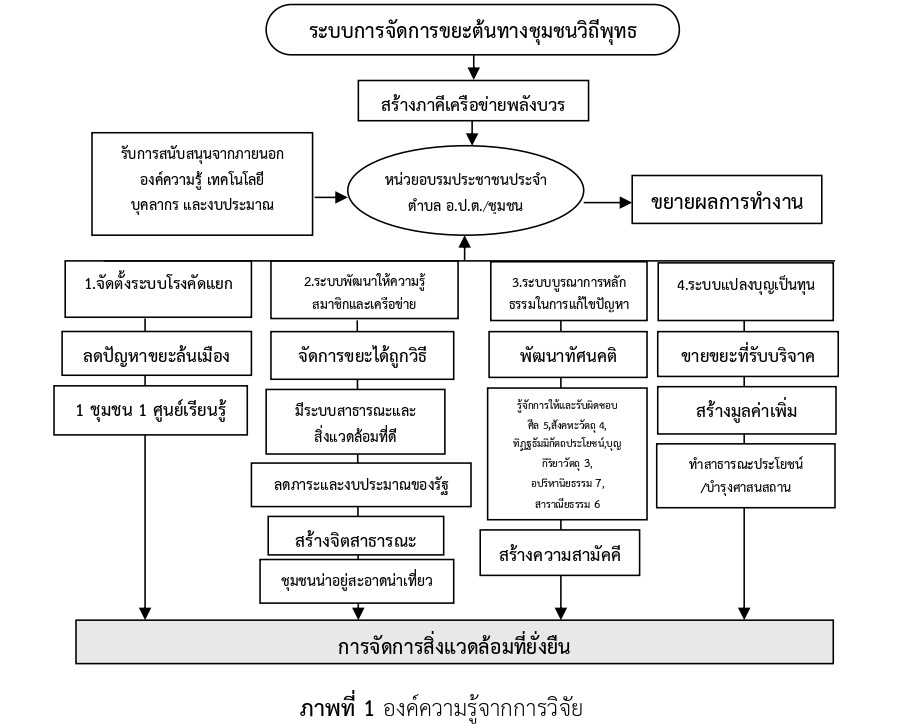THE CREATING A WASTE MANAGEMENT SYSTEM ORIGINATES AS THE BUDDHIST COMMUNITY
Keywords:
Creating A Waste Management System at Source, Buddhist Community, Sustainable Environmental Management ModelAbstract
This article aims to 1. Study the problems and impacts of waste management at source 2. Create volunteer leaders and develop a waste management system at the household level 3. Propose a sustainable environmental management model and expand the results in the prototype area. This is qualitative research, divided into 2 methods: document research to study and analyze spatial problems, and field action research using participatory observation and focus group discussion. The research areas are: 1. 4 communities in Nong Klap Subdistrict, Nong Bua District, Nakhon Sawan Province 2. 1 community in Tha Kwang Subdistrict, Saraphi District, Chiang Mai Province Key informants include 6 representatives of government agencies, 6 representatives of religious organizations and community leaders, and 6 representatives of the public, totaling 18 people. Data was analyzed using content analysis techniques.
The study results found that 1. The main problems of waste management at the source in Buddhist communities include the accumulation of waste that affects the environment and health, lack of responsibility and public participation, and lack of knowledge in sorting and managing waste. Solving the problem requires community cooperation, such as effective waste management control, knowledge provision, and environmental awareness. 2. Guidelines for developing a household waste management system include: 1. Sorting waste from the home, such as organic waste, recyclable waste, and hazardous waste; 2. Making merit with certain types of waste; 3. Selling or using waste for public benefit, such as recycling; 4. Making the community clean and livable; 3. Expanding sustainable environmental management will help the community benefit, including: 1. Creating added value from waste and recycled materials; 2. Strengthening community unity; 3. Instilling environmental awareness, which will affect the development and prosperity of the community in the long term.
References
กระทรวงมหาดไทย. (2566). แผนปฏิบัติการจัดการขยะมูลฝอยชุมชน “จังหวัดสะอาด” ประจำปี พ.ศ.2566. สืบค้นเมื่อ 10 เมษายน 2566, จาก https://drive.
google.com/drive/folders/1nBD1qfiMi7Qw4j-bLJJbAgrWLPNKt04M.
ชาญชัย ชัยรุ่งเรือง. (2559). การมีส่วนร่วมของประชาชนในการสร้างชุมชนเข้มแข็งของเทศบาลนครปากเกร็ด จังหวัดนนทบุรี. วารสาร มจร สังคมศาสตร์ปริทรรศน์, 5(2), 115-128.
พรพิมล แก้วอ่อน. (2565). แนวทางการพัฒนาทักษะภาวะผู้นำในศตวรรษที่ 21 ตามหลักทุติยปาปณิกสูตร ของผู้บริหารโรงเรียนในกลุ่มโรงเรียนฟ้าอุดม สังกัดสำนักงานเขตพื้นที่การศึกษาประถมศึกษานครสวรรค์ เขต 3. วารสารวิจยวิชาการ, 5(2), 91-104.
สำนักงานคณะกรรมการพัฒนาการเศรษฐกิจและสังคมแห่งชาติ. (2561). ยุทธศาสตร์ชาติระยะ 20 ปี (พ.ศ. 2561-2580). สืบค้น 14 มกราคม 2565. จาก http://nscr.nesdc.go.th/wp-content/uploads/2023/06/NS_PlanOct201
สุขุมาลย์ ประสมศักดิ์. (2556). กลยุทธ์การมีส่วนร่วมของประชาชนในการจัดการสิ่งแวดล้อมตามหลักพุทธธรรมขององค์การบริหารส่วนจังหวัด ในกลุ่มจังหวัดภาคกลางตอนบน (ดุษฎีนิพนธ์พุทธศาสตรดุษฎีบัณฑิต สาขาวิชารัฐประศาสนศาสตร์). พระนครศรีอยุธยา: มหาวิทยาลัยมหาจุฬาลงกรณราชวิทยาลัย.

Downloads
Published
How to Cite
Issue
Section
Categories
License
Copyright (c) 2025 Academic Journal of Political Science and Public Administration

This work is licensed under a Creative Commons Attribution-NonCommercial-NoDerivatives 4.0 International License.



